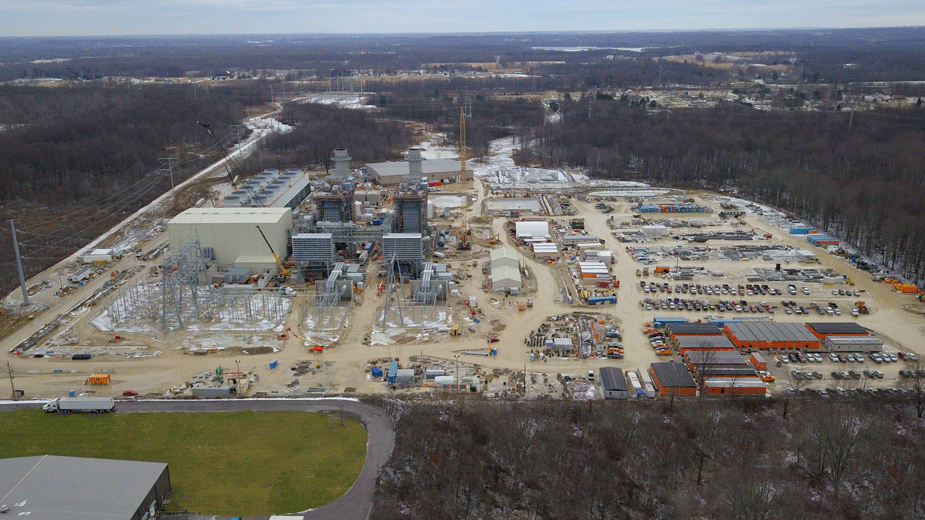Testimony Wraps Up in Fight Over 2nd Power Plant
WARREN, Ohio – Testimony concluded late Tuesday in a case that may determine whether a second $900 million electrical generation plant is built in Lordstown.
Trumbull County Common Pleas Judge Peter Kontos said he would rule on the matter in about a week after attorneys for Clean Energy Future LLC and Clean Energy Future Lordstown submit their final briefs before the court. He instructed attorneys to file their final arguments by May 4.
However, he urged both parties to find some middle ground and work toward a possible solution before he issues a ruling.
That appears unlikely at this time, noted Bill Siderewicz, president of Clean Energy Future, who indicated the legal sparring is far from over even after this part of the case is finished.
Although the first three words of the company names are the same, they are different entities — one with their name ending in Lordstown, the other with the designation LLC.
Clean Energy Future Lordstown, which owns the Lordstown Energy Center under construction in the village, argues that should a second plant be built at the site, it could cost its operation $6.7 million a year — a cost the company thinks should be absorbed by Clean Energy Future LLC.
“They’re looking for an extortion payment,” Siderewicz said. “We’re not going to pay them a dime.”
Siderewicz and Clean Energy Future LLC developed the first Lordstown plant, and 70% of that project is now owned by Macquarie, an international equity firm. Siemens Financial owns 25% of the project and CEF owns roughly 5%.
 The view from a drone in January above the site of the Lordstown Energy Center.
The view from a drone in January above the site of the Lordstown Energy Center.
But now that the Lordstown Energy Center is under construction, Siderewicz says that the plant’s major investor, Macquarie is working to either kill or delay the construction of a second power plant at the Lordstown Industrial Park, which would be called the Trumbull Energy Center.
Clean Energy Future LLC filed a complaint Sept. 20 in Trumbull County Common Pleas Court, claiming that Macquarie was intentionally holding up development of a second energy plant at the Lordstown Industrial Park, arguing they breached an agreement by refusing to sign an addendum that would override park stipulations so a second plant could be built.
Under the agreement to construct the first plant, Clean Energy Lordstown – and majority owner Macquarie – would own the land next to where the Lordstown plant is being built. That same agreement says that Clean Energy Future would have the first option to purchase that land and use it as the site to build the second electrical plant.
Judge Kontos in November affirmed an earlier order issued by Magistrate Jami Bishop that Macquarie and Clean Energy Lordstown must sign the document. After an appeals court and the Ohio Supreme Court dismissed Clean Energy Lordstown’s challenge to the order, company representatives signed the addendum.
At issue before the court on Friday is whether an option-to-purchase agreement signed by Clean Energy Future and Clean Energy Future Lordstown, can go forward without additional conditions so work could begin on the second electrical generation plant.
However, Clean Energy Lordstown is now holding off on signing away the land needed to construct the second plant, arguing that it needs the land to accommodate potential future needs such as a cooling pond, easements, noise abatement systems, a dual fuel system and additional warehouse space.
In all, Clean Energy Lordstown presented 22 reasons why the Lordstown Energy Center needed this land. The list was compiled after the parties had signed the agreement in April 2016.
The court heard testimony Friday from Thomas White, a Chicago energy consultant who assisted Macquarie on portions of the project.
White testified that Clean Energy Lordstown was in no way trying to delay, kill or impede the Trumbull Energy Center project. And he cited a study performed by analysts that found that building a second plant at that site could cost the Lordstown Energy Center $6.7 million a year in profitability once the Trumbull operation started.
Under cross-examination, however, White acknowledged that most of the 22 items on the list are not a necessity for the Lordstown Center at this point.
“There would be no impact today,” White testified. “But, in the future, it could reduce profitability and our ability to operate.”
White also acknowledged another consulting study performed by Charles River Associates before the agreement was signed found that a second plant at the site would have minimal impact on the Lordstown Energy Center project.
The most important issues for the Lordstown Energy Center are easements for a natural gas line to the plant, a widened electrical utility pathway, and a storm sewer, which Siderewicz said didn’t pose a problem. Plus, Siderewicz said that Macquarie has the right of first offer to invest in the new project, but have thus far declined to do so.
“They’ve come up with 22 fictitious reasons why they say they need this land,” Siderewicz said, noting the Lordstown Energy Center has asked the Trumbull Energy Center to subsidize its operation at $6.7 million for the life of the plant, which could be more than 40 years.
Should Macquarie not be interested in the Trumbull Energy Center, then there are other investors who would be, Siderewicz noted.
Meanwhile, Siderewicz said that the longer Macquarie and Clean Energy Lordstown engage in stall tactics, the more money the Trumbull Energy project loses.
“They’ve done tens of millions of dollars worth of damage to the Trumbull Energy project,” he said, leaving open the door for another lawsuit – this one for punitive damages.
“We would request an expedited jury trial asking in excess of $100 million in damages,” Siderewicz said.
Still, Siderewicz said he’s optimistic that construction on the second plant could begin this year, should all of the legal hurdles becleared.
The new plant would employ some 850 construction tradesmen at the site, and provide Warren with $100 million in water sales through the life of the plant.
“We would be looking to break ground probably by November,” he said.
Pictured: Bill Siderewicz, president of Clean Energy Future.
Copyright 2024 The Business Journal, Youngstown, Ohio.



